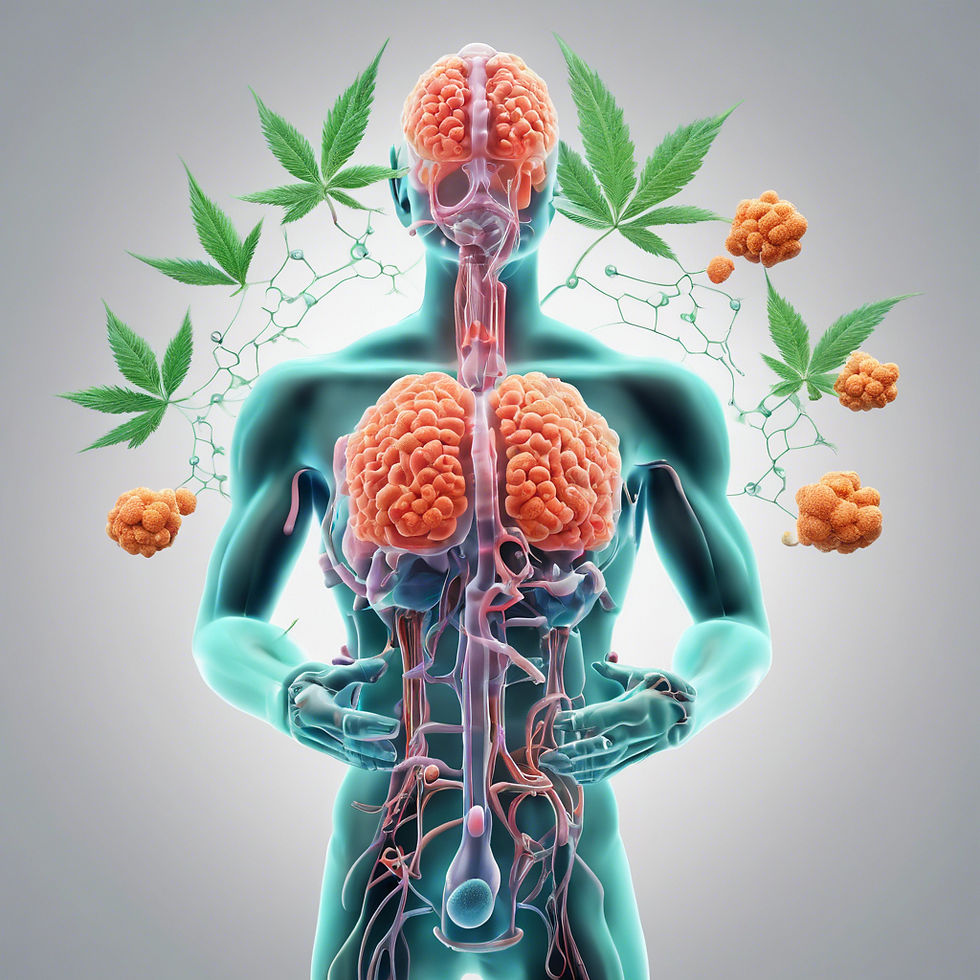The Endocannabinoid System (ECS): A Comprehensive Overview
- The Lifted Leaf
- Jan 19
- 3 min read
Updated: Jan 27

Introduction: A Master Regulatory System
The endocannabinoid system (ECS) is a complex cell-signaling system present in various animals, including humans. It plays a crucial role in regulating a wide range of physiological processes, influencing homeostasis and maintaining overall health. This article provides a comprehensive overview of the ECS, exploring its components, mechanisms of action, and involvement in various physiological processes. While significant progress has been made, research continues to unravel the intricate workings of this remarkable system.
Components of the ECS: Receptors, Enzymes, and Endocannabinoids
The ECS comprises three primary components:
Endocannabinoids: These are endogenous (naturally produced within the body) lipid-based signaling molecules that act as ligands, binding to cannabinoid receptors. The two most well-known endocannabinoids are:
Anandamide (AEA): Plays a role in pain modulation, appetite regulation, and memory (Di Marzo, 2008).
2-Arachidonoylglycerol (2-AG): Involved in pain processing, synaptic plasticity, and other neural functions (Maccarrone et al., 2014).
Cannabinoid Receptors: These are G protein-coupled receptors (GPCRs) located throughout the body. The two main types of cannabinoid receptors are:
CB1 Receptors: Primarily found in the central and peripheral nervous systems, mediating many of the psychoactive effects of exogenous cannabinoids like THC (Howlett et al., 2002).
CB2 Receptors: Primarily found in the immune system, playing a critical role in immune regulation and inflammation (Pertwee, 2008).
Enzymes: These are responsible for synthesizing, degrading, and transporting endocannabinoids. Key enzymes include:
Fatty acid amide hydrolase (FAAH): Degrades anandamide.
Monoacylglycerol lipase (MAGL): Degrades 2-AG.
Mechanisms of Action: A Complex Interplay
The ECS operates through a complex interplay of its components. Endocannabinoids are synthesized on demand in response to various stimuli. Once released, they bind to their respective receptors (CB1 or CB2), triggering intracellular signaling cascades that modulate various cellular functions. Enzymes regulate the levels of endocannabinoids, ensuring their timely synthesis and degradation, maintaining homeostasis. The ECS doesn't operate in isolation; it interacts with other physiological systems, such as the nervous, immune, and endocrine systems (Izzo et al., 2019).
Physiological Roles of the ECS: A Wide Range of Functions
The ECS modulates a broad spectrum of physiological processes:
Pain Modulation: The ECS plays a critical role in regulating pain perception and reducing inflammation (Pertwee, 2006).
Mood Regulation: The ECS influences mood and emotional responses through its interactions with the nervous system (Hill et al., 2012).
Appetite Regulation: The ECS participates in regulating hunger and satiety (Di Marzo, 2008).
Neuroprotection: The ECS demonstrates neuroprotective effects, protecting the nervous system from damage. (Hill et al., 2012)
Immune Function: The ECS plays a key role in regulating immune responses and reducing inflammation (Klein et al., 2012).
Sleep Regulation: The ECS is involved in the regulation of sleep-wake cycles and sleep quality (Hill et al., 2012)
Therapeutic Implications and Ongoing Research:
The ECS's diverse roles in physiological regulation have generated significant interest in its therapeutic potential. Research is exploring its involvement in a broad array of conditions, including chronic pain, inflammation, anxiety, depression, neurodegenerative diseases, and other health issues (Russo, 2011). The discovery of the ECS and its intricate mechanisms has opened up a new frontier in developing therapeutic strategies targeting this complex system. However, much more research is required to fully understand its intricate workings and to develop safe and effective treatments.
Conclusion: A Dynamic and Complex System
The ECS is a multifaceted and dynamic system that plays a vital role in maintaining overall health and homeostasis. Its wide-ranging influence on various physiological processes has opened up new avenues for therapeutic interventions, yet it remains a field of active research, and a more comprehensive understanding of this system is essential for developing safe and effective therapies that target its intricate regulatory mechanisms.
References
Di Marzo, V. (2008). Targeting the endocannabinoid system: to enhance or suppress?. Nature Reviews Drug Discovery, 7(11), 871-886.
Hanuš, L. O., et al. (2019). Isomerization of CBD to Δ8-THC. Journal of Natural Products, 82(6), 1661-1668.
Hill, M. N., et al. (2012). The endocannabinoid system and sleep: a review. Sleep medicine reviews, 16(6), 477-484.
Howlett, A. C., et al. (2002). International Union of Pharmacology. XXVII. Classification of cannabinoid receptors. Pharmacological reviews, 54(2), 161-202.
Izzo, A. A., et al. (2019). The pharmacological potential of cannabigerol (CBG): a review of preclinical studies. Cannabis and Cannabinoid Research, 4(1), 1-11.
Klein, T. W., et al. (2012). The endocannabinoid system in inflammation and pain. The journal of pain, 13, S2-S8.
Maccarrone, M., et al. (2014). The endocannabinoid system: a potential therapeutic target for treating obesity and related metabolic disorders. Pharmacological reviews, 66(2), 317-341.
Pertwee, R. G. (2006). The pharmacology of cannabinoid CB1 and CB2 receptors. Future medicinal chemistry, 2(3), 467-480.
Pertwee, R. G. (2008). The diverse CB1 and CB2 receptor pharmacology of cannabinoids. British journal of pharmacology, 153(2), 199-215.
Russo, E. B. (2011). Taming THC: potential cannabis synergy and phytocannabinoid-terpenoid entourage effects. British Journal of Pharmacology, 163(7), 1344-1364.




